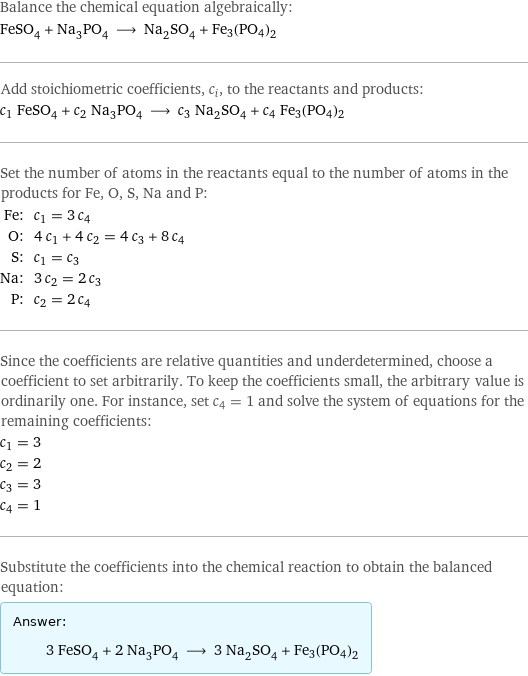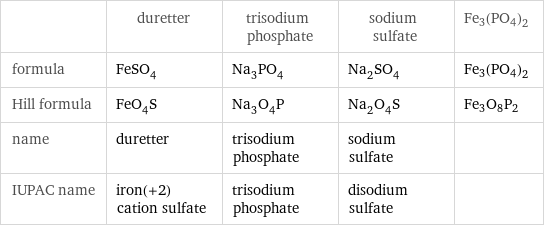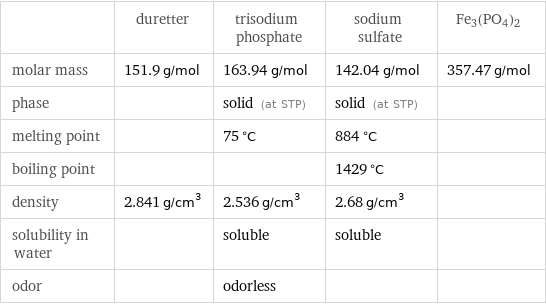Input interpretation

FeSO_4 duretter + Na_3PO_4 trisodium phosphate ⟶ Na_2SO_4 sodium sulfate + Fe3(PO4)2
Balanced equation

Balance the chemical equation algebraically: FeSO_4 + Na_3PO_4 ⟶ Na_2SO_4 + Fe3(PO4)2 Add stoichiometric coefficients, c_i, to the reactants and products: c_1 FeSO_4 + c_2 Na_3PO_4 ⟶ c_3 Na_2SO_4 + c_4 Fe3(PO4)2 Set the number of atoms in the reactants equal to the number of atoms in the products for Fe, O, S, Na and P: Fe: | c_1 = 3 c_4 O: | 4 c_1 + 4 c_2 = 4 c_3 + 8 c_4 S: | c_1 = c_3 Na: | 3 c_2 = 2 c_3 P: | c_2 = 2 c_4 Since the coefficients are relative quantities and underdetermined, choose a coefficient to set arbitrarily. To keep the coefficients small, the arbitrary value is ordinarily one. For instance, set c_4 = 1 and solve the system of equations for the remaining coefficients: c_1 = 3 c_2 = 2 c_3 = 3 c_4 = 1 Substitute the coefficients into the chemical reaction to obtain the balanced equation: Answer: | | 3 FeSO_4 + 2 Na_3PO_4 ⟶ 3 Na_2SO_4 + Fe3(PO4)2
Structures

+ ⟶ + Fe3(PO4)2
Names

duretter + trisodium phosphate ⟶ sodium sulfate + Fe3(PO4)2
Equilibrium constant
![Construct the equilibrium constant, K, expression for: FeSO_4 + Na_3PO_4 ⟶ Na_2SO_4 + Fe3(PO4)2 Plan: • Balance the chemical equation. • Determine the stoichiometric numbers. • Assemble the activity expression for each chemical species. • Use the activity expressions to build the equilibrium constant expression. Write the balanced chemical equation: 3 FeSO_4 + 2 Na_3PO_4 ⟶ 3 Na_2SO_4 + Fe3(PO4)2 Assign stoichiometric numbers, ν_i, using the stoichiometric coefficients, c_i, from the balanced chemical equation in the following manner: ν_i = -c_i for reactants and ν_i = c_i for products: chemical species | c_i | ν_i FeSO_4 | 3 | -3 Na_3PO_4 | 2 | -2 Na_2SO_4 | 3 | 3 Fe3(PO4)2 | 1 | 1 Assemble the activity expressions accounting for the state of matter and ν_i: chemical species | c_i | ν_i | activity expression FeSO_4 | 3 | -3 | ([FeSO4])^(-3) Na_3PO_4 | 2 | -2 | ([Na3PO4])^(-2) Na_2SO_4 | 3 | 3 | ([Na2SO4])^3 Fe3(PO4)2 | 1 | 1 | [Fe3(PO4)2] The equilibrium constant symbol in the concentration basis is: K_c Mulitply the activity expressions to arrive at the K_c expression: Answer: | | K_c = ([FeSO4])^(-3) ([Na3PO4])^(-2) ([Na2SO4])^3 [Fe3(PO4)2] = (([Na2SO4])^3 [Fe3(PO4)2])/(([FeSO4])^3 ([Na3PO4])^2)](../image_source/aabe95787737880aad2817a697b61ac5.png)
Construct the equilibrium constant, K, expression for: FeSO_4 + Na_3PO_4 ⟶ Na_2SO_4 + Fe3(PO4)2 Plan: • Balance the chemical equation. • Determine the stoichiometric numbers. • Assemble the activity expression for each chemical species. • Use the activity expressions to build the equilibrium constant expression. Write the balanced chemical equation: 3 FeSO_4 + 2 Na_3PO_4 ⟶ 3 Na_2SO_4 + Fe3(PO4)2 Assign stoichiometric numbers, ν_i, using the stoichiometric coefficients, c_i, from the balanced chemical equation in the following manner: ν_i = -c_i for reactants and ν_i = c_i for products: chemical species | c_i | ν_i FeSO_4 | 3 | -3 Na_3PO_4 | 2 | -2 Na_2SO_4 | 3 | 3 Fe3(PO4)2 | 1 | 1 Assemble the activity expressions accounting for the state of matter and ν_i: chemical species | c_i | ν_i | activity expression FeSO_4 | 3 | -3 | ([FeSO4])^(-3) Na_3PO_4 | 2 | -2 | ([Na3PO4])^(-2) Na_2SO_4 | 3 | 3 | ([Na2SO4])^3 Fe3(PO4)2 | 1 | 1 | [Fe3(PO4)2] The equilibrium constant symbol in the concentration basis is: K_c Mulitply the activity expressions to arrive at the K_c expression: Answer: | | K_c = ([FeSO4])^(-3) ([Na3PO4])^(-2) ([Na2SO4])^3 [Fe3(PO4)2] = (([Na2SO4])^3 [Fe3(PO4)2])/(([FeSO4])^3 ([Na3PO4])^2)
Rate of reaction
![Construct the rate of reaction expression for: FeSO_4 + Na_3PO_4 ⟶ Na_2SO_4 + Fe3(PO4)2 Plan: • Balance the chemical equation. • Determine the stoichiometric numbers. • Assemble the rate term for each chemical species. • Write the rate of reaction expression. Write the balanced chemical equation: 3 FeSO_4 + 2 Na_3PO_4 ⟶ 3 Na_2SO_4 + Fe3(PO4)2 Assign stoichiometric numbers, ν_i, using the stoichiometric coefficients, c_i, from the balanced chemical equation in the following manner: ν_i = -c_i for reactants and ν_i = c_i for products: chemical species | c_i | ν_i FeSO_4 | 3 | -3 Na_3PO_4 | 2 | -2 Na_2SO_4 | 3 | 3 Fe3(PO4)2 | 1 | 1 The rate term for each chemical species, B_i, is 1/ν_i(Δ[B_i])/(Δt) where [B_i] is the amount concentration and t is time: chemical species | c_i | ν_i | rate term FeSO_4 | 3 | -3 | -1/3 (Δ[FeSO4])/(Δt) Na_3PO_4 | 2 | -2 | -1/2 (Δ[Na3PO4])/(Δt) Na_2SO_4 | 3 | 3 | 1/3 (Δ[Na2SO4])/(Δt) Fe3(PO4)2 | 1 | 1 | (Δ[Fe3(PO4)2])/(Δt) (for infinitesimal rate of change, replace Δ with d) Set the rate terms equal to each other to arrive at the rate expression: Answer: | | rate = -1/3 (Δ[FeSO4])/(Δt) = -1/2 (Δ[Na3PO4])/(Δt) = 1/3 (Δ[Na2SO4])/(Δt) = (Δ[Fe3(PO4)2])/(Δt) (assuming constant volume and no accumulation of intermediates or side products)](../image_source/7b6a48141e0a6284d43a8ce17d38477b.png)
Construct the rate of reaction expression for: FeSO_4 + Na_3PO_4 ⟶ Na_2SO_4 + Fe3(PO4)2 Plan: • Balance the chemical equation. • Determine the stoichiometric numbers. • Assemble the rate term for each chemical species. • Write the rate of reaction expression. Write the balanced chemical equation: 3 FeSO_4 + 2 Na_3PO_4 ⟶ 3 Na_2SO_4 + Fe3(PO4)2 Assign stoichiometric numbers, ν_i, using the stoichiometric coefficients, c_i, from the balanced chemical equation in the following manner: ν_i = -c_i for reactants and ν_i = c_i for products: chemical species | c_i | ν_i FeSO_4 | 3 | -3 Na_3PO_4 | 2 | -2 Na_2SO_4 | 3 | 3 Fe3(PO4)2 | 1 | 1 The rate term for each chemical species, B_i, is 1/ν_i(Δ[B_i])/(Δt) where [B_i] is the amount concentration and t is time: chemical species | c_i | ν_i | rate term FeSO_4 | 3 | -3 | -1/3 (Δ[FeSO4])/(Δt) Na_3PO_4 | 2 | -2 | -1/2 (Δ[Na3PO4])/(Δt) Na_2SO_4 | 3 | 3 | 1/3 (Δ[Na2SO4])/(Δt) Fe3(PO4)2 | 1 | 1 | (Δ[Fe3(PO4)2])/(Δt) (for infinitesimal rate of change, replace Δ with d) Set the rate terms equal to each other to arrive at the rate expression: Answer: | | rate = -1/3 (Δ[FeSO4])/(Δt) = -1/2 (Δ[Na3PO4])/(Δt) = 1/3 (Δ[Na2SO4])/(Δt) = (Δ[Fe3(PO4)2])/(Δt) (assuming constant volume and no accumulation of intermediates or side products)
Chemical names and formulas

| duretter | trisodium phosphate | sodium sulfate | Fe3(PO4)2 formula | FeSO_4 | Na_3PO_4 | Na_2SO_4 | Fe3(PO4)2 Hill formula | FeO_4S | Na_3O_4P | Na_2O_4S | Fe3O8P2 name | duretter | trisodium phosphate | sodium sulfate | IUPAC name | iron(+2) cation sulfate | trisodium phosphate | disodium sulfate |
Substance properties

| duretter | trisodium phosphate | sodium sulfate | Fe3(PO4)2 molar mass | 151.9 g/mol | 163.94 g/mol | 142.04 g/mol | 357.47 g/mol phase | | solid (at STP) | solid (at STP) | melting point | | 75 °C | 884 °C | boiling point | | | 1429 °C | density | 2.841 g/cm^3 | 2.536 g/cm^3 | 2.68 g/cm^3 | solubility in water | | soluble | soluble | odor | | odorless | |
Units
